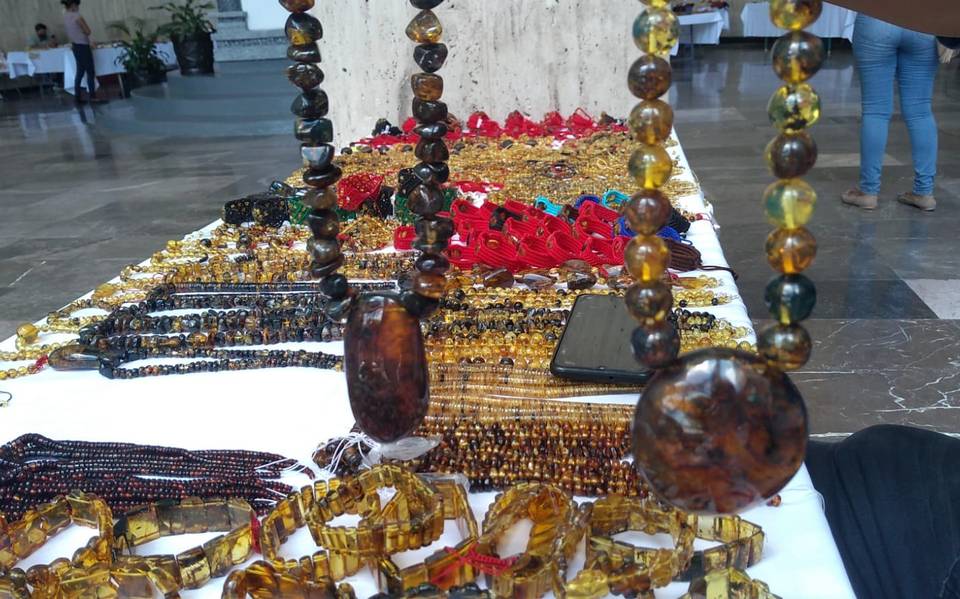
Joyería de ámbar
Uno de los grandes orgullos de Chiapas es el ámbar, es un producto de resina petrificada, que posee una belleza y calidad, por lo que es considerada una piedra semipreciosa. Los artesanos expertos elaboran joyería con este ámbar que se puede encontrar en colores transparentes amarillos o en tonos oscuros.
El ámbar de Chiapas tiene cualidades únicas, ya que es considerado como una excelente solución para alejar los malos espíritus o envidias en contra de los niños que se enferman de mal de ojo. El nombre de ámbar en Chiapas significa “la materia que aleja a los malos espíritus”.
- Textiles y tejidos
En los diseños textiles de Chiapas se usan colores llamativos, además tienen representación de flores, mariposas y otros animales característicos de la región. Hay una gran variedad de diseños, formas y propósitos, como piezas de uso cotidiano como manteles, servilletas, cojines y demás.
Estas artesanías son muy significativas y representan la gran diversidad cultural de Chiapas. En los textiles se puede encontrar el testimonio de una cultura viva que ha permanecido generación con generación. La vestimenta del estado habla de un pasado y un presente de los Chiapanecos en sus trajes típicos.
- Alfarería
En diferentes municipios de Chiapas se elaboran piezas con barro, que además que algunas piezas tienen un uso utilitario, son consideradas como obras de arte las cuales se crean con la finalidad de ser admiradas y transmitir algún mensaje del artista. Hay creaciones como jarrones, macetas, ollas o piezas que son solo decorativas que serán un increíble recuerdo de este bello estado.
Amatenango del Valle se destaca por su antigua tradición alfarera que evidencia fuertes rasgos prehispánicos. Algunos artesanos han tenido la posibilidad de viajar al exterior para comercializar sus productos.
Vive los hermosos paisajes del Cañón del Sumidero en Chiapas
Vive la emoción del Cañón del Sumidero
Disfruta del increíble sabor del pozol de cacao chiapaneco
Aprende la receta del pozol de cacao de Chiapas
- Talabartería
La talabartería o curtido y acabado de cuero en piel tiene especial tradición artesanal en municipios como San Cristóbal de las Casas y Comitán. En Chiapas se caracteriza por tener muchos los talleres que se dedican a la elaboración de objetos y piezas como bolsas, sillas de montar, zapatos, fundas de cuchillos y machetes, mochilas, sandalias o productos de caballería entre otros.
- Maque o laca
Esta técnica es ancestral desde tiempos prehispánicos, inclusos se han recuperado vestigios en las excavaciones arqueológicas de la cueva de La Garrafa en Chiapas.
Esta artesanía de Chiapas consiste en cortezas de frutos como calabazas o jícaras pintadas con óleo y luego esmaltadas. Esta técnica fue evolucionando con la llegada de los españoles, aunque estuvo a punto de desaparecer, pero con el apoyo del estado para la producción y comercialización, aún sigue en pie en Chiapas de Corzo, también en otros estados como Michoacán y Guerrero.
Actualmente esta técnica de la laca se usa no solo en frutos, también en otros objetos como instrumentos musicales, máscaras, juguetes, muebles, cofres y baúles.
INGLES
amber jewelry
One of the great prides of Chiapas is amber, it is a product of petrified resin, which has beauty and quality, which is why it is considered a semi-precious stone. Skilled artisans make jewelry from this amber which can be found in transparent yellow colors or dark shades.
Chiapas amber has unique qualities, since it is considered an excellent solution to ward off bad spirits or envy against children who get sick from the evil eye. The name amber in Chiapas means “the matter that wards off evil spirits.”
- Textiles and fabrics
Bright colors are used in the textile designs of Chiapas, and they also have representations of flowers, butterflies and other animals characteristic of the region. There is a wide variety of designs, shapes and purposes, as well as everyday pieces such as tablecloths, napkins, cushions and more.
These crafts are very significant and represent the great cultural diversity of Chiapas. In textiles you can find the testimony of a living culture that has remained generation after generation. The clothing of the state speaks of a past and a present of the Chiapas in their typical costumes.
- Pottery
In different municipalities of Chiapas, pieces are made with clay, which, in addition to some pieces having a utilitarian use, are considered works of art which are created with the purpose of being admired and transmitting a message from the artist. There are creations such as vases, pots, pots or pieces that are only decorative that will be an incredible souvenir of this beautiful state.
Amatenango del Valle stands out for its ancient pottery tradition that shows strong pre-Hispanic features. Some artisans have had the opportunity to travel abroad to market their products.
Experience the beautiful landscapes of the Sumidero Canyon in Chiapas
Live the excitement of the Sumidero Canyon
Enjoy the incredible flavor of Chiapas cacao pozol
Learn the recipe for Chiapas cacao pozol
- Saddlery
Saddlery or tanning and finishing leather has a special artisanal tradition in municipalities such as San Cristóbal de las Casas and Comitán. Chiapas is characterized by having many workshops that are dedicated to the production of objects and pieces such as bags, saddles, shoes, knife and machete sheaths, backpacks, sandals or cavalry products, among others.
- Maque or lacquer
This technique has been ancestral since pre-Hispanic times, vestiges have even been recovered in the archaeological excavations of the La Garrafa cave in Chiapas.
This craft from Chiapas consists of fruit rinds such as pumpkins or gourds painted with oil and then enamelled. This technique evolved with the arrival of the Spanish, although it was on the verge of disappearing, but with the support of the state for production and marketing, it is still alive in Chiapas de Corzo, as well as in other states such as Michoacán and Guerrero.
Currently this lacquer technique is used not only on fruits, but also on other objects such as musical instruments, masks, toys, furniture, chests and trunks.
